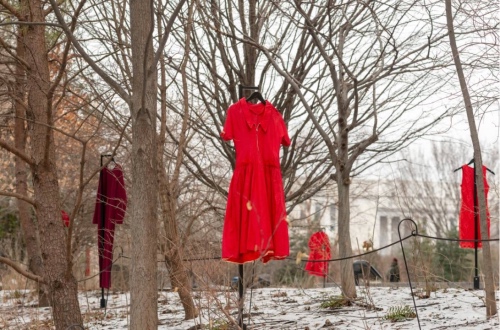Washington, DC
Thomson Reuters Foundation
Dozens of empty red dresses sway in the wind at the foot of Capitol Hill, reminding passersby of the thousands of native women recorded murdered or missing in the United States and Canada in recent decades.
An art installation launched this month at the National Museum of the American Indian in Washington, DC, spotlights the “epidemic” of violence against indigenous women and girls across the continent.

Dresses hang on the grounds of the National Museum of the American Indian in Washington, DC on 1st March, as part of the REDress Project, an art installation by artist Jaime Black. PICTURE: National Museum of the American Indian staff.
“I hadn’t really heard that this epidemic was so widespread until my teen years,” said Jaime Black, the artist behind the REDress Project, adding that it aimed to fill “a space where there was a lot of silence”.
“These empty red dresses hang in public spaces so people can encounter the absence and violence against indigenous women and girls,” she told the Thomson Reuters Foundation ahead of the museum’s first symposium on the topic on Thursday.
More than four in five Native American women have experienced violence in their lifetime, according to the National Institute of Justice.
In 2016, the US National Crime Information Center reported 5,712 cases of missing native women.
Similarly high rates are seen in Canada – where the REDress show originated – with a 2014 national report by the Royal Canadian Mounted Police estimating 1,181 indigenous women disappeared or were murdered since 1980.
The situation is a “silent crisis”, US Representative Deb Haaland, one of the first two Native American women elected to Congress, said last week during congressional testimony.
Black, who is based in Winnipeg, Canada, created the project in 2009, and it has toured extensively throughout the country. This is its first showing in the United States, she said.
Sarah Deer, a professor at the University of Kansas who studies gender issues, said “the movement [around recognition of missing native women] really started in Canada, but the story and the issues and histories and law are almost identical” in the United States.
It was only in the late 1990s that the US Government began to collect data on murdered and missing indigenous women, Deer said, noting that non-native people commit the vast majority of violence against native women and girls.
Poring over data is “a really dehumanising way of discussing this problem,” Deer said, “but it wasn’t until the data came that we got a real foothold in the world of policymakers.”
Still, information collection remains poor, advocates say, and last year the Urban Indian Health Institute warned of an ongoing “nationwide data crisis” on the issue, particularly in cities.
Legislative proposals in Congress would strengthen data collection and create national guidelines on how law enforcement should respond to cases of missing or murdered indigenous people.
Black said she is less interested in government solutions than in the grassroots indigenous “revival” she has seen in the decade that she has been doing the REDress Project – such as the Idle No More aboriginal protest movement.
That initiative, she noted, was started by women.





